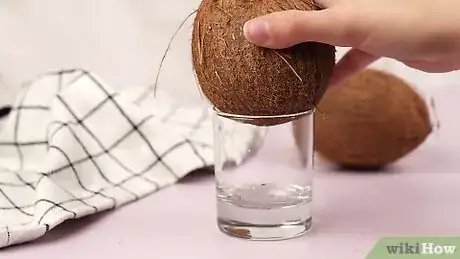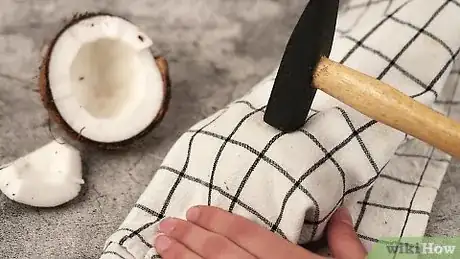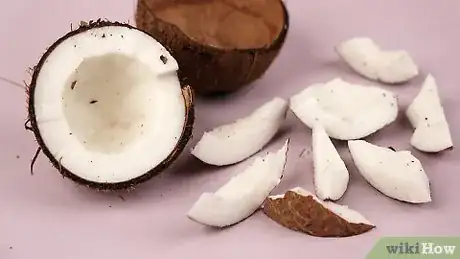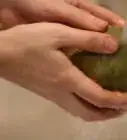This article was co-authored by wikiHow staff writer, Luke Smith, MFA. Luke Smith is a wikiHow Staff Writer. He's worked for literary agents, publishing houses, and with many authors, and his writing has been featured in a number of literary magazines. Now, Luke writes for the content team at wikiHow and hopes to help readers expand both their skillsets and the bounds of their curiosity. Luke earned his MFA from the University of Montana.
There are 10 references cited in this article, which can be found at the bottom of the page.
The wikiHow Video Team also followed the article's instructions and verified that they work.
This article has been viewed 2,970,384 times.
Learn more...
Whole coconuts can be a little daunting, and you might shy away from using them in your recipes because of their imposing, hard shells. But the secret to opening a coconut is just a little persistence and elbow grease—with the oven on standby as the ace up your sleeve. We’re here to spill the secrets to cracking open even the most colossal coconut with our simple guide to draining, hammering, heating, and peeling a whole coconut. As a bonus, we’ll show you how to make a totally tropical coconut cup out of a young coconut. So roll up your sleeves and grab a mallet. Let’s get cracking.
Things You Should Know
- Drain your coconut by using a screwdriver and mallet to bore a hole into one the coconut’s eyes, then turning the coconut upside down over a glass.
- Use a hammer or mallet to strike all along the equator of the coconut, until the coconut breaks apart or forms a crack large enough to prise apart.
- Heat your coconut in the oven or microwave before you strike it with a hammer to make it easier to split apart.
- Slice the white casing off of a young coconut, then use the back of a sturdy knife to strike all around the equator until the young coconut splits apart.
Steps
Draining the Coconut
-
1Poke a hole in the “eye” of the coconut with a screwdriver and a mallet. Position the pointed end of a screwdriver on one of the 3 holes or “eyes” at the top of the coconut. Then, use a mallet or hammer to carefully but forcefully bore a hole through an eye. Once the screwdriver gives (indicating it’s bored through the shell), remove it by wiggling it out, widening the new hole in the process.[1]
- You can also use a sharp, sturdy knife or a metal skewer to bore the hole.
-
2Turn the coconut upside down over a glass and allow it to drain. Let the coconut sit for several minutes or until all of the liquid drains out. You may need to shake the coconut a few times to get the last bit of water out of it.[2]
- An average coconut expels approximately ½ to ¾ cup (118 to 177 ml) of water.
- The water from a fresh, young coconut should be sweet. If the liquid has an oily consistency, the coconut likely isn’t good and should be thrown away.
Advertisement -
3Drink or use the coconut water in a recipe. Coconut water is high in electrolytes, which aid in keeping you hydrated. Unlike sports drinks, however, coconut water is low in calories and carbs, which make it an ideal alternative.[3] Drink it as-is, freeze it to make popsicles, or mix it into a virgin cocktail.[4]
- You can also simply dispose of your coconut water by pouring it down the drain.
Using a Hammer
-
1Wrap the mature coconut in a kitchen towel. Place the coconut in the center of the towel, and gather the corners of the towel together to form a pouch. This will keep coconut bits from flying when you go to smash it with a hammer.[5]
- Use a worn kitchen towel, or one you don’t mind roughing up a bit, since you may damage the towel in this process.
-
2Use a hammer or mallet to firmly strike all around the coconut. Place the wrapped coconut on a solid surface and hold it in place with one hand. Then, minding your fingers, strike the coconut’s center with a hammer or mallet. Turn the wrapped coconut slightly, and strike the center again. Use as much force as you can safely apply, and repeat until the coconut breaks apart beneath the towel.[6]
- Wrap the coconut in a towel before striking it. This may be more comfortable for some, and will prevent pieces from flying when you strike the coconut.
- If your coconut splits into 2-3 larger pieces, place the pieces meat-side down on a towel, and strike them again to split them into smaller pieces that are easier to handle.
-
3Alternatively, strike the coconut against a concrete surface. If you don’t have a hammer or mallet, you can use a solid surface like a porch or possibly a concrete countertop. Try to strike the coconut’s equator against the corner of this surface, using it as a makeshift wedge. Repeatedly strike the coconut all around its equator until the coconut breaks apart.[7]
-
4Use a knife to separate the meat from the shell. Remove the coconut pieces from the towel. Take each piece, and wedge a knife between the shell and the white meat of the coconut to carefully separate the two. Then, use the knife (or a vegetable peeler) or remove the fibrous layer that might still be clinging to the outside of the meat.[8]
- You don’t necessarily have to use a sharp knife to separate the coconut meat and shell. It’s best to start with a butter knife and only move onto a sharp knife if you’re having trouble.
- Steady the pieces of coconut as you’re separating the coconut shell and meat by bracing it against your table or counter.
Using an Oven
-
1Preheat the oven to 400 °F (204 °C) and bake the coconut for 15-20 minutes. Place the mature coconut on a baking sheet, and monitor it as it bakes (you only want to bake the coconut for as long as it takes to form a crack—baking it for much longer may burn it). After 15 minutes, check for cracks in the coconut. If no cracks have formed, give it another 5 minutes in the oven, or until the coconut has developed fault lines.[9]
- You’ll still need to use force to open the coconut after heating it, either by hammering it or whacking it against a hard surface, but heating the coconut first makes this process easier.
-
2Alternatively, microwave the coconut on high for 3 minutes. This method is handy when you’re pressed for time, or don’t want to fuss around with an oven. The coconut may not crack, and you may need to exert more force to open it later, but the shell will become weaker and generally easier to penetrate.[10]
-
3Remove the coconut and wrap it in a towel to cool. Use oven mitts to retrieve the coconut from the oven or microwave, and allow it to cool for about 5 minutes while wrapped in a towel. Doing this ensures you don’t have hot coconut bits flying everywhere when you go to smash it in the next step.[11]
-
4Whack the wrapped coconut with a hammer, or bash it against a hard surface. With the coconut still wrapped in the towel, use a hammer or a mallet to repeatedly and forcefully whack the coconut. Turn the coconut as you hammer it, in order to strike it from multiple angles. Hammer it until you feel it break open beneath the towel.[12]
- Alternatively, swing the coconut in the towel against a hard surface until it breaks. Use a surface like concrete, and avoid whacking it against your countertop. This could break your counter!
-
5Separate the coconut meat from the shell with a knife. Take each coconut fragment and slip a knife between the shell and the white meat of the coconut to separate the two. Then, use the knife to remove the fibrous layer that might still be clinging to the outside of the meat, in a similar manner to how you’d peel an apple..[13]
- You can also use a vegetable peeler to remove the fibrous layer that clings to the coconut meat.
Opening a Young Coconut
-
1Use a knife to shave off the tender white casing. Position your young coconut on a cutting board, and use a sharp cleaver or a sturdy chef’s knife to slice off the outer casing. Carve at an angle, as if you were removing the skin from an apple, until you expose the hard inner shell. Work to expose as much of the shell as possible.[14]
- A young coconut has a softer, thick, white-colored casing surrounding the familiar brown shell inside.
-
2Identify the softest eye, and bore a hole through it to drain the coconut water. Though the eyes will be covered by the white casing, as you shave off the casing, you’ll find 3 circular white spots arranged in a triangle. These are the eyes of the coconut. Press the point of your knife into each, until you find the one that gives way the most easily. Use your knife to bore a hole into the inside of the coconut, then invert the coconut over a glass to drain.[15]
- The shell on a younger coconut is softer and easier to penetrate than that of a mature coconut, so a knife will do here.
- Alternatively, instead of draining the coconut, use the inner point of the knife (close to the handle), to perforate an opening closer to the top of the coconut. Continue this until you can pry the section away like a lid. Stick a straw in the opening, and use the coconut as a natural cup for the coconut water inside![16]
-
3Strike the back of the knife around the equator of the coconut until it splits. Use the back, dull edge of the knife to firmly whack all around the equator of the coconut. Continue doing so for 2-3 full rotations of the coconut, or until it splits. You may need to use the point of the knife to prise apart the coconut after you’ve formed a good crack.[17]
- Once you’ve opened the coconut, peel away the inside meat as in the steps above.
Our Most Loved Articles & Quizzes
Community Q&A
-
QuestionWhat do I do with the coconut meat?
 JenniferBlairCommunity AnswerYou can eat the meat directly from the coconut after you open it, or use it in any recipe that calls for fresh coconut.
JenniferBlairCommunity AnswerYou can eat the meat directly from the coconut after you open it, or use it in any recipe that calls for fresh coconut. -
QuestionCan I drink the water inside a coconut?
 Community AnswerYes, you can, coconut water is full of vitamins and it’s very hydrating.
Community AnswerYes, you can, coconut water is full of vitamins and it’s very hydrating. -
QuestionWhen I opened my coconut, I found a thick, garlic-like material instead of water. Is the coconut safe to use?
 JenniferBlairCommunity AnswerIf you notice that the water in the coconut is thick, oily, or chunky, it likely means that the coconut is old and no longer fresh. You should discard it.
JenniferBlairCommunity AnswerIf you notice that the water in the coconut is thick, oily, or chunky, it likely means that the coconut is old and no longer fresh. You should discard it.
Warnings
- Never try to bite open a coconut. It will not open it and will break your teeth.⧼thumbs_response⧽
- Be very careful when hitting the coconut with the mallet. The coconut should be hit firmly but not so hard that you lose control of the mallet. You don’t want to accidentally hit your hand.⧼thumbs_response⧽
- Don't put the coconut in the oven if you haven’t drained it. It might explode if it is left for too long and the water turns into steam, creating high pressure inside.⧼thumbs_response⧽
- Always handle sharp knives with care.⧼thumbs_response⧽
Things You'll Need
Draining the Coconut
- Sharp knife
- Glass, bowl, or measuring cup
Using a Hammer
Using an Oven
References
- ↑ https://www.seriouseats.com/diy-coconut-rum-homemade-captain-morgans-recipe
- ↑ https://recipes.net/articles/how-to-open-a-coconut/
- ↑ https://health.clevelandclinic.org/the-health-benefits-of-coconut-water/
- ↑ https://food.ndtv.com/recipe-coconut-water-with-lemon-and-mint-776192
- ↑ https://recipes.net/articles/how-to-open-a-coconut/
- ↑ https://recipes.net/articles/how-to-open-a-coconut/
- ↑ https://recipes.net/articles/how-to-open-a-coconut/
- ↑ https://www.seriouseats.com/diy-coconut-rum-homemade-captain-morgans-recipe
- ↑ https://culinarylore.com/how-to-guides:how-to-break-open-coconut/
- ↑ https://www.chicagotribune.com/news/ct-xpm-1988-10-27-8802100940-story.html
- ↑ https://www.chicagotribune.com/news/ct-xpm-1988-10-27-8802100940-story.html
- ↑ https://recipes.net/articles/how-to-open-a-coconut/
- ↑ https://www.seriouseats.com/diy-coconut-rum-homemade-captain-morgans-recipe
- ↑ https://youtu.be/1H-9MiBGp8I?t=21
- ↑ https://www.youtube.com/watch?v=1H-9MiBGp8I&t=45s
- ↑ https://www.youtube.com/watch?v=0i_PYmrMXoQ&t=58s
- ↑ https://www.youtube.com/watch?v=1H-9MiBGp8I&t=97s
About This Article
To open a coconut, start by poking a hole in the top with a knife and draining out all the water. Then, bake the coconut in the oven at 375° F (190°C) for 10 minutes or until a crack forms in the shell. Once the shell is cracked, take the coconut out of the oven and put it in a plastic bag. Then, hit the bag against a hard surface until the coconut breaks open. As always, be sure to exercise caution when handling a knife to avoid injury.




























































